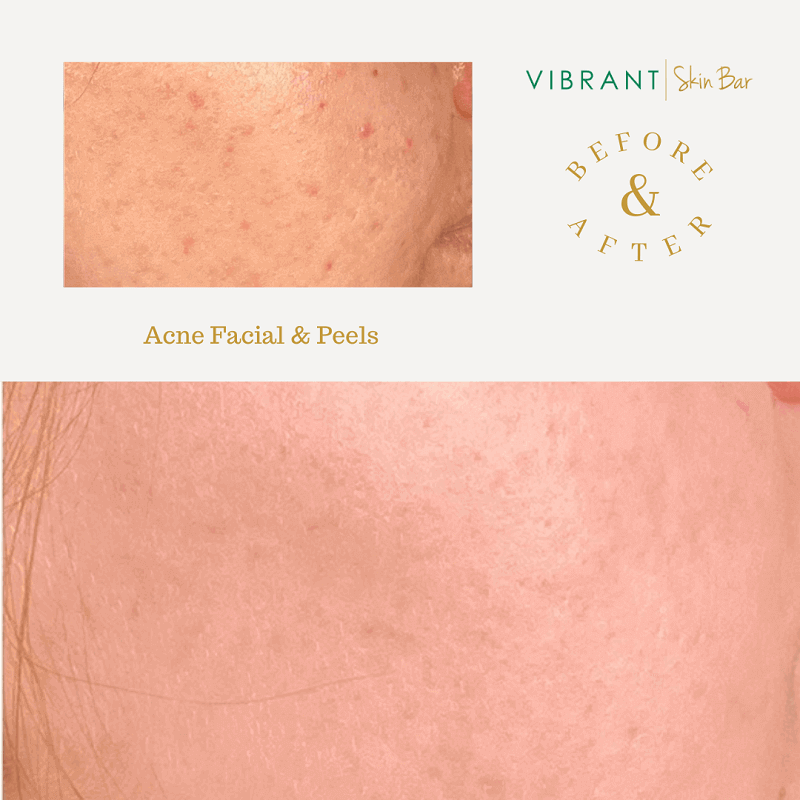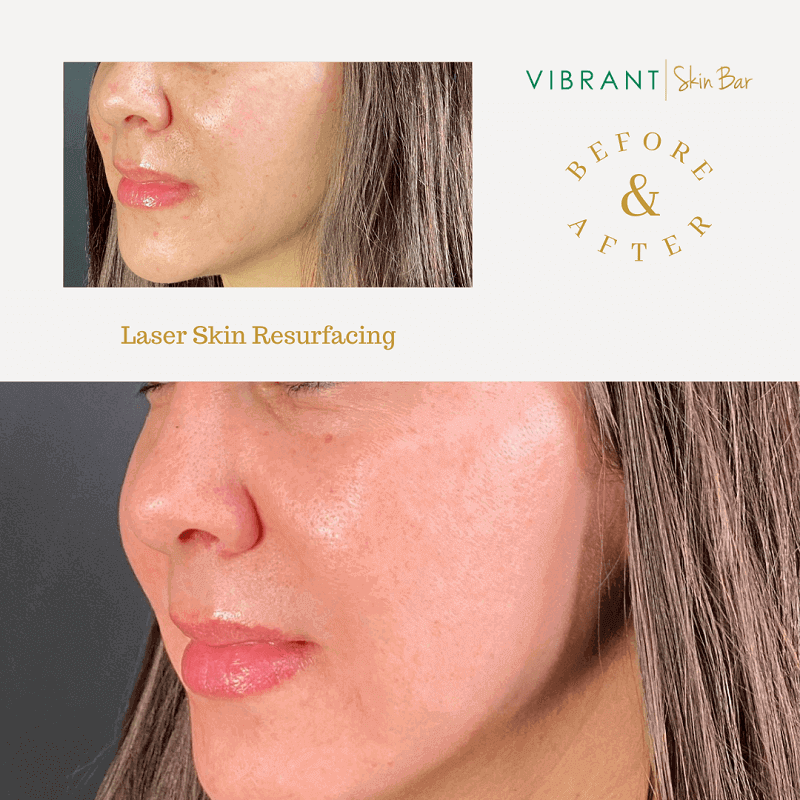Advances in the cosmetic industry have introduced numerous ways to reverse the signs of aging. Among the most popular are chemical peels and laser therapy, valued for their anti-aging potential, versatility, and wide range of benefits. Both treatments have several levels of intensity, allowing customization based on each patient’s unique skin concerns.
This article provides a detailed comparison of chemical peels and laser treatments, highlighting their pros and cons and addressing the most frequently asked questions.

What Is a Chemical Peel?
A chemical peel is a skin resurfacing treatment that exfoliates the skin using carefully applied chemical solutions.
These solutions create controlled damage to the outer layers, removing dead cells and stimulating the growth of fresh, youthful-looking skin.
Types of Chemical Peels
There are three types of chemical peels based on how deeply they penetrate the skin.
Light (Superficial) Peels
Light peels provide subtle results that last about a month and require no downtime. They can reduce mild sun damage, fine lines, dryness, and minor blemishes.
They use low-concentration formulas with gentle acids, including:
- Alpha hydroxy acids (AHAs) – Include glycolic acid, lactic acid, mandelic acid, and citric acid, suitable for dry and sensitive skin.
- Beta hydroxy acids (BHAs) - Salicylic acid, ideal for oily, acne-prone skin.
- Polyhydroxy acids (PHAs) – Gluconolactone and lactobionic acid, suitable for sensitive, dry, and rosacea-prone skin.
- Enzyme peels (fruit enzymes) - Papain (papaya), bromelain (pineapple), and pumpkin enzymes, suitable for gentle exfoliation of sensitive skin.
Superficial peels are safe for all skin types and tones, including sensitive and darker skin.
Medium Peels
Medium peels penetrate deeper skin layers and provide more visible results but require recovery time of up to one week. They target moderate wrinkles and creases, sun damage, uneven skin tone, different types of acne scars, and post-inflammatory hyperpigmentation.
Mild peels use different concentrations of the following acids:
- Trichloracetic acid (TCA) – Effective for pigmentation issues, sun damage, wrinkles, and acne scars.
- Jessner’s solution - A combination of salicylic acid, lactic acid, and resorcinol that improves acne, uneven tone, and fine lines.
- TCA and Jessner’s solution – A blend used for stubborn pigmentation issues, like melasma; Jessner’s is typically applied first to enhance absorption of TCA.
- Glycolic acid – Higher concentrations of glycolic acid address mild scarring, photodamage, and discoloration.
Deep Peels
Deep peels cause a dramatic skin transformation that lasts for years, but the procedure carries more risk and requires anesthesia, as well as a recovery time of up to several months.
Skin experts often recommend laser resurfacing instead of deep peels because the two treatments provide similar results, with the laser therapy carrying less risk of complications.
Deep peel formulas can contain the following:
- Phenol – Carbolic acid (phenol) is the gold standard of deep chemical peels; it produces the most dramatic anti-aging results, alleviating deep wrinkles, severe sun damage, and precancerous lesions.
- Phenol-based combinations – The Baker-Gordon formula combines phenol with croton oil, distilled water, and Septisol to reduce deep folds and persistent photoaging.
- High-strength TCA – Solutions with 50% of TCA or higher are rarely used alone due to risks, but can sometimes be combined with phenol and other acidic agents.
What Is a Laser Treatment?
Laser resurfacing uses a laser device that sends controlled pulsed light to the targeted areas. The light energy heats the skin layers, stimulating collagen production and natural healing.
The procedure tightens the skin, improves tone, and reduces imperfections, including wrinkles, acne scars, and blemishes.
Photofacial treatments, such as IPL and BBL, use intense pulsed light to penetrate upper dermal layers, increasing collagen and elastin production and rejuvenating the complexion.
Note: Learn what skin conditions a BBL laser treatment can address.
Types of Laser Treatments
All laser techniques are grouped into two main categories: ablative and non-ablative. Both types can be delivered through fractional or non-fractional laser technology.
Fractional lasers create microscopic treatment zones by targeting only a fraction of the skin at a time, leaving surrounding tissue intact to promote faster healing and collagen production. Non-fractional lasers, on the other hand, treat the entire skin surface in the targeted area, which can deliver more dramatic results but often requires longer recovery.
Non-Ablative Laser Therapy
Non-ablative lasers heat the skin to stimulate collagen production without peeling the skin’s top layer. They promote cell turnover and bring rejuvenated skin to the surface.
Note: At Vibrant Skin, we offer gentle, non-ablative MOXI™ laser technology to rejuvenate the skin and prevent premature aging.
Ablative Laser Therapy
Ablative laser treatments peel off the skin’s outer layer (epidermis) and heat the underlying layer (dermis), stimulating collagen production. They are more invasive and produce more dramatic results but require longer downtime.
Chemical Peel vs. Laser: What Are the Differences?
The following table sums up the main differences between chemical peels and laser resurfacing treatments.
| Chemical Peel | Laser Treatment | |
| How It Works | A chemical solution exfoliates the skin’s outer layers, revealing fresher, smoother, and rejuvenated skin underneath. | A laser device heats the outer skin layers, stimulating collagen production and revealing fresher, smoother skin. |
| Types | Light, medium, and deep. | Ablative and non-ablative. |
| Conditions It Treats | Age spots, discoloration, hyperpigmentation, fine lines and wrinkles, acne, and acne scars. | Fine lines and deep wrinkles, acne scars, blemishes, large pores, spider veins, warts, dark spots, and sagging skin. |
| Skin Types | Light peels are safe for all skin types. Darker skin tones carry the risk of post-inflammatory hyperpigmentation. | Gentle, non-ablative lasers are safe for all tones, but there is a higher risk of pigment changes in darker skin with ablative lasers. |
| Risks and Side Effects | Common: redness, swelling, itching, and scaling. Severe: infection, scarring, and discoloration. Deep peels may cause liver, heart, or kidney damage. | Common: redness, swelling, stinging, flaking, scabbing, and itching. Severe: infection, scarring, burns, blisters, cold sores, and permanent hyperpigmentation. |
| Frequency of Treatments | Six sessions spaced two weeks apart, followed by monthly maintenance for acne treatment. One session every six to eight weeks for mild imperfections and sensitive skin types. | Four or more sessions, each delivered a month apart. |
| Recovery Time | No downtime for light peels. Up to one week for medium peels. Up to several months for deep peels. | Up to two weeks. |
| Duration of Results | One month for light peels. Four to six months for medium peels. Up to ten years for deep peels. | Three to five years. |
Note: Read about how chemical peels compare to microneedling.
Chemical Peel vs. Laser: Procedures
Both are non-surgical, minimally invasive, outpatient procedures that can easily fit into a busy schedule. Recovery time depends on the type and intensity of the treatment.
Chemical peel
Chemical peels use chemical solutions to exfoliate and resurface the skin. Light peels do not require numbing creams and anesthesia because they are typically painless, while medium peels may require sedation. Deep peels are more intensive and usually require IV sedation with local or general anesthesia.
During the procedure, the provider applies the solution to the targeted area and leaves it to penetrate the skin for 10-30 minutes before neutralizing and cleansing the skin.
Laser treatment
For non-ablative laser treatments, a numbing cream may be applied, while some ablative techniques, such as CO2 laser therapy, may require sedation and anesthesia.
During the procedure, the provider handles a laser device to send pulsating light to the targeted area. Unlike chemical peels, which typically treat the entire face, lasers can provide spot treatment, focusing on one specific area – a scar, crow’s feet, or other specific concerns.
Chemical Peel vs. Laser Skin: Conditions
Both treatments are versatile and address a wide range of skin and medical conditions.
Chemical peel
Chemical peels even out skin tone and texture and minimize sun damage. Light peels are beneficial for superficial skin imperfections, while medium and deep peels effectively reduce atrophic scars left by severe acne or chickenpox.
Peel treatments can alleviate the following skin conditions:
- Mild to moderate acne
- Back acne (bacne)
- Acne scars
- Discoloration (e.g., age spots, liver spots)
- Photodamage
- Uneven skin texture
- Dryness
- Fine lines and wrinkles
- Dead skin cell removal
- Xanthelasma (yellow plaques near the eyelids)
- Precancerous growths (actinic keratosis)
Laser treatment
The medical provider customizes a laser therapy plan according to the patient’s specific skin concerns and the severity of symptoms.
Various laser resurfacing techniques can be used to treat the following conditions:
- Age spots
- Sun damage
- Melasma
- Freckles
- Fine lines and wrinkles
- Acne scars
- Large pores
- Rosacea
- Skin laxity
- Uneven skin tone
- Rough texture
- Spider veins
- Broken capillaries
- Unwanted hair
Chemical Peels vs. Laser: Depth of Treatment
This comparison chart highlights key differences between different types of chemical peels and laser treatments based on how deep they penetrate the skin.
| Chemical peels | Laser treatments |
| Light peels affect only the outermost layer (the epidermis). | Non-ablative lasers penetrate the middle skin layer (the dermis) while leaving the outer layer (the epidermis) intact. |
| Medium peels penetrate the epidermis and upper dermis. | Ablative-lasers heat the underlying dermis while removing the outer skin layer. |
| Deep peels reach the mid-to-lower dermis, causing more dramatic resurfacing. | The depth of fractional and non-fractional lasers depends on whether they are ablative or non-ablative. |
Chemical Peel vs. Laser: Pain Level
Discomfort levels vary depending on the patient's pain threshold and the intensity of the treatment.
Chemical peels
Light peels require no numbing creams or anesthesia, and patients describe the sensation as mild tingling, stinging, or warmth.
Medium peels are well-tolerated but may require numbing cream or mild sedation. You may feel a mild burning or stinging sensation during the procedure.
Deep peels are the most painful type and typically require IV sedation and local or general anesthesia.
Laser treatment
Laser resurfacing may include the application of numbing creams, anesthetics, and sedatives, depending on the type of treatment.
Non-ablative lasers can feel like prickling and are well-tolerated with numbing creams.
Ablative lasers may require both numbing cream and local anesthesia, depending on the intensity of the treatment.
Chemical Peel vs. Laser: Results
Peels and lasers provide both short-term and long-term skin benefits. The results depend on the type of treatment and the number of maintenance sessions required.
Chemical peels
Chemical peels improve the tone and texture of sun-damaged skin, reduce the appearance of wrinkles and acne scars, and rejuvenate the skin. Light chemical peels require maintenance treatments every four to six weeks, while deep peels provide long-lasting results.
- Light peels yield results within two to five days, and the skin remains bright and smooth for up to a month.
- Medium peels produce visible improvements after a week, with results lasting up to a year.
- Deep peels deliver first results after two to three weeks, when the healing is complete, and the effects can last for years.

Laser treatment
Laser resurfacing is more effective at reducing acne scars and deep wrinkles. The results may last up to five years, depending on the laser treatment type.
- The initial results of non-ablative laser therapy become visible within 1 to 3 weeks and continue to improve gradually, with effects lasting six months to two years with regular maintenance.
- Ablative lasers produce noticeable improvements after 1 to 2 weeks, with results lasting up to five years with proper lifestyle and skin care.

Chemical Peel vs. Laser: Side Effects
Chemical peels and laser treatments are safe when performed by licensed, experienced medical professionals. Their safety also depends on carefully following the pre- and post-treatment skincare instructions given to you by your provider. Still, both procedures carry certain risks and may provoke unwanted reactions.
Chemical Peels
Medium peels cause more irritation than light peels, and deep peels carry the highest risk of side effects and the longest recovery.
Common side effects include:
- Redness
- Swelling
- Itching
- Scaling
- Dryness
- Flaking
- Crusting
- Sun sensitivity
- Temporary pigmentation
Rare side effects are the following:
- Infection
- Scarring
- Permanent hyperpigmentation
- Delayed healing
- Heart damage (deep peels)
- Kidney damage (deep peels)
- Liver damage (deep peels)
Laser treatment
Non-ablative lasers cause mild, temporary side effects, while ablative lasers carry the highest risk of complications, with longer downtime.
These are the most common reactions:
- Redness
- Swelling
- Itching
- Dryness
- Peeling
- Temporary pigmentation issues
- Mild discomfort
- Acne flare-ups
- Sun sensitivity
Rare side effects include:
- Infection
- Scarring
- Acne
- Ectropion (eyelid turning outward)
- Persistent pigment changes
- Skin damage
- Prolonged redness
- Delayed wound healing
Chemical Peel vs. Laser: Aftercare
Follow your medical provider’s aftercare recommendations to minimize the risks of side effects and complications from chemical peels and laser resurfacing.
Here are general aftercare tips that apply to both treatments:
- Do not touch, pick, scratch, or apply pressure on the treated areas.
- Avoid the sun, tanning beds, saunas, and hot tubs.
- Avoid strenuous exercise and other activities that involve heavy sweating.
- Use gentle, microbiome-friendly skincare products.
- Use moisturizers regularly to restore the skin barrier and prevent drying.
- When outdoors, wear a wide-brimmed hat and apply a broad-spectrum, mineral-based sunscreen with SPF 30 or higher.
- Avoid cleansing brushes, exfoliation, and at-home facial scrubs.
- Wait at least 24 to 48 hours before applying makeup to avoid irritation.
Note: Find out more about aftercare guidelines following a chemical peel treatment.
Chemical Peel vs. Laser: Cost
The cost of a chemical peel and laser treatment depends on the type of treatment, the severity of the skin issue, and the medical provider’s expertise and location.
You can get the following chemical peels at Vibrant Skin:
- Light peel | $99
- Medium peel | $125
- Revita-Pen Infusion | $199
- BioRePeel | $349
At Vibrant Skin, we offer the following laser treatments:
- BBL | $349 (or 4 treatments for $1200)
- Forever Clear | $300 (or 8 treatments for $2000)
- SkinTyte | $500 (or 4 treatments for 1500)
- Halo | $1200
- Halo Pro | $2400
Is a Chemical Peel Better Than a Laser Treatment?
The question is not whether treatment is better than the other, but which one better fits your needs. Both procedures improve skin texture and tone, reduce fine lines and wrinkles, and fade sunspots.
Chemical peels are better for patients with darker skin and for treating superficial irregularities, mild scars, and acne. Laser resurfacing is more effective for treating deeper wrinkles and surgical scars, providing targeted spot treatment and stimulating stronger collagen remodeling.
Your medical provider will help you decide during the consultation based on your skin issue, budget, skin goals, and how much time you can spend on recovery. Sometimes, skin experts recommend a combination of these two treatments for the best results.
Chemical Peel vs. Laser: Frequently Asked Questions
If you are considering combining a peel with a laser for enhanced results, or if you are still unsure which treatment is best for your skin concern, the following FAQ section will guide you.
Should You Do a Laser or a Chemical Peel First?
Skin experts recommend starting with a chemical peel first, as it removes dead skin cells from the surface, allowing the laser to penetrate more effectively and stimulate collagen production.
A superficial peel is the safest choice since it only exfoliates the outermost layer and involves little to no downtime.
How Long After a Chemical Peel Can I Get a Laser?
Dermatologists recommend waiting up to two weeks between a light chemical peel and a laser treatment to ensure the skin has fully healed and restored its barrier.
The recovery period minimizes potential irritation, allowing the skin to respond more effectively to the laser. Depending on your skin sensitivity, the provider may advise a slightly longer period to ensure safety and maximize the results.
Is a Laser or a Chemical Peel Better for Dark Skin?
Peels and laser resurfacing are both equally effective for lighter skin tones. Patients with darker complexions may benefit more from chemical peels as laser treatments pose the risk of unwanted results, such as discoloration and skin damage. Deeper peels and fully ablative laser treatments are not recommended for dark skin tone as they carry more risks and side effects.
Consult your medical provider to determine the best course of action for your skin tone and the issue you want to treat.
Is Laser or a Peel Better for Acne?
Both treatments can improve the appearance of acne and acne scars, and you can customize and combine them to maximize the outcome.
Peels are more suitable for mild to moderate acne and post-acne scars, while lasers deliver better results for severe acne and deeper scarring.
Peels can also enhance the absorption of topical medication, allowing serums and creams to penetrate more deeply and prevent future breakouts.
Is a Chemical Peel or Laser Better for Sunspots?
Lasers are effective for deep sunspots because they target them more precisely and break down the pigment by penetrating deeper into the skin.
Chemical peels are a more affordable option for mild to moderate, surface-level pigmentation issues. They can even out skin tone, but do not offer dramatic results.
Conclusion
Chemical peels and laser therapy are powerful solutions for skin rejuvenation, effectively treating sun damage, acne, scars, and signs of aging to achieve a smoother, more youthful complexion. With guidance from your medical provider, you can choose the treatment best suited to your needs.
Weigh the pros and cons of each option and consult our skin experts to discover the most effective path to radiant, younger-looking skin. Contact our skin experts for more information.


